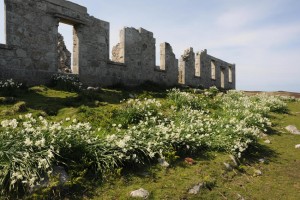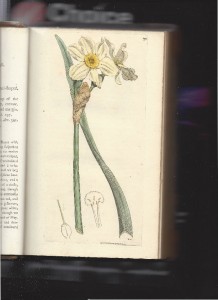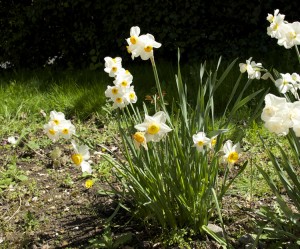 I have lived in Somerset for 40 years and my regular coastal walks have been punctuated by the tempting sight of Lundy Island peeping through the sea mist and each time I saw it I made a promise to visit it. Thus it was that one sunny day at the end of April 2011 we finally took the 2 hour boat trip to see the puffins. Sadly it was still too early for them but we had an excellent walk clockwise round the island. As we made the return leg down the more sheltered east side back to the ferry we passed through the long uninhabited hamlet of Quarry Cottages –little more than a few walls, perched on the top of the 400 ft cliffs.
I have lived in Somerset for 40 years and my regular coastal walks have been punctuated by the tempting sight of Lundy Island peeping through the sea mist and each time I saw it I made a promise to visit it. Thus it was that one sunny day at the end of April 2011 we finally took the 2 hour boat trip to see the puffins. Sadly it was still too early for them but we had an excellent walk clockwise round the island. As we made the return leg down the more sheltered east side back to the ferry we passed through the long uninhabited hamlet of Quarry Cottages –little more than a few walls, perched on the top of the 400 ft cliffs.
 Abandoned houses were to be expected – the island population is now 23 down from 100+ in its early seventeenth century heyday but what we had not thought to see were huge stands of daffodils blowing in the wind, filling the remains of the gardens. There were literally hundreds of them, all identical; twin headed with rather small scented white flowers and ragged yellow cups perched above luxuriant and very healthy foliage. There was no sign of any other daffodil varieties in this hamlet. I realised that they were probably N. x medioluteus, otherwise known as Primrose Peerless. This was confirmed by checking them against my own commercial stock. Later searches by the Lundy Field Society found no other stocks of this variety on the island.
Abandoned houses were to be expected – the island population is now 23 down from 100+ in its early seventeenth century heyday but what we had not thought to see were huge stands of daffodils blowing in the wind, filling the remains of the gardens. There were literally hundreds of them, all identical; twin headed with rather small scented white flowers and ragged yellow cups perched above luxuriant and very healthy foliage. There was no sign of any other daffodil varieties in this hamlet. I realised that they were probably N. x medioluteus, otherwise known as Primrose Peerless. This was confirmed by checking them against my own commercial stock. Later searches by the Lundy Field Society found no other stocks of this variety on the island.
The delightful late flowering N x medioluteus, under its descriptive synonym N.biflorus, has a long history in the gardens of Europe. For many centuries it was believed to be a species but William Herbert in his notes in the Botanical Register Vol. 29, 1843 discussing the status of 4 so called species, wrote with a wonderful sense of outrage that “although most of these plants had been cultivated above 200 years their places of abode were unknown and a suspicion arose that they were artificial breeds which some cultivator had imposed upon the public as mountain plants.” He requested seed of them and although plants were recorded as growing “wild” in France, “where it is common” and also Madeira where it was naturalised under (also non indigenous) chestnuts; no one could find any. He then set about replicating the crosses – there were 4 so called mules under investigation at this time and the “result of experiment enables me to assert that those suspicions are now verified.” Although he did not actually replicate the cross in the case of N.biflorus he “entertained no doubt concerning the latter” (biflorus) and he was certain it was of hybrid origin. He then goes on to boldly state that “All must be expunged from the botanical catalogue of natural genera or species!” Recent Italian rDNA1 evidence has finally confirmed his suspicions, 150 years later – that it was a sterile hybrid between N. tazetta and N. poeticus.
There is no extant evidence for its origin although most sources suggest S France from which it has spread throughout Europe. We know that on 15 February 1605 some bulbs of N medioluteus “les bulbs seulement” were sent by Peiresc, along with the seeds of other plants, to Clusius in Leiden at his request. Nicolas-Claude Fabri de Peiresc (1 December 1580 – 24 June 1637), was a French astronomer and savant, who maintained a wide correspondence with other scientists. We do not know whether Clusius already knew the plant, they had met at an earlier date in Holland, and whether they were collected from a wild source or from Peiresc’s own garden in Aix en Provence.
The first mention in British literature is by Gerard in 1597 (book 1, chapter 17) who records “Primerose peereless that is most common in our country gardens, generally knowne every where” and elsewhere as “growing wild in fields and sides of woods in the West of England.” It appears in the list of plants growing in his garden2 in 1596-1599 as “N. medio luteus, daffodil with the yellow circle”. In 1629 Parkinson recorded it as being very common in country gardens throughout England. “If this plant had only appeared lately, I should have thought it had been produced by the Dutch florists; but as it was unquestionably in most of our country gardens, so early as the 15th century, it is most probably one of Nature’s mules.””( a wild hybrid)
It continued to thrive in Britain and in 1793 it was illustrated in Curtis Bot Mag Vol. 6 with the description “As it grows readily, increases in a greater degree than most others and is both ornamental and odoriferous, it is no wonder that we meet with it in almost every garden, and that in abundance, flowering towards the end of April,… It usually produces two flowers, hence we have called it biflorus.”
It was first botanically described as Narcissus medio-luteus, the currently accepted name, by Miller in his Gardeners’ Dictionary in 1768: “Daffodil with two flowers in a sheath, a short bell-shaped nectarium, and nodding flowers. Common Daffodil with a yellow middle , called Primrose Peerless.” It was felt that the name biflorus was misleading as it sometimes produced one and occasionally three flowers. He goes on to say in in the 8th and final edition “grows naturally in the South of France and in Italy, and has been found growing in the Fields in some Parts of England, but it is likely to have been from some Roots which have been thrown out of Gardens with Rubbish. . . . commonly but one Flower in a Sheath, but sometimes when the roots are strong, they have two. The Flower nods downward, the Segments of the Petal are a little waved on their Edges, . . . Cup is short, and bordered with yellow; it flowers in May.”3
 Whilst on the subject of names it is worth recording some of the descriptive names applied to this flower. A plethora of common names is a good indication of a long history of cultivation. Sowerby in his English Botany calls it Pale Narcissus or Primrose peerless
Whilst on the subject of names it is worth recording some of the descriptive names applied to this flower. A plethora of common names is a good indication of a long history of cultivation. Sowerby in his English Botany calls it Pale Narcissus or Primrose peerless
but I was surprised to find that there are so many in the USA indicating that it has long been cultivated there as well. Indeed I have just received an email from Charleston, Mass. saying that it is growing well in their garden. Most names are purely descriptive: Twin Sisters, two flowered narcissus ,Loving Couples, pale narcissus; or associated with their late flowering time: April Narcissus, Easter Lilies, April Beauty, but Cemetery Ladies makes one wonder – location or fragrance? Sowerby notes that it “is fragrant, but the smell if continued becomes unpleasant” an unfortunate characteristic shared with some other tazettas when cut. The colloquial Spanish name for Narcissus Paperwhite translates as ‘fox piss’ and they are never cut for the house there though they are abundant in the fields and verges. (Potted ones, as we grow them in UK, keep their sweet scent almost to the end). In the early 20C the Easter Lily was still extensively grown as a cut flower along the Tamar valley. Because the bulbs were not lifted every 2 years as they are today in commercial cut flower fields the clumps quickly became congested, impairing the flowering. Their colloquial name there was “One’s and Two’s”4.
In the last half century it seems to have either disappeared from our countryside or perhaps just dropped below the radar as the upsurge in modern daffodil breeding produced more and more beautiful hybrids and the old fashioned varieties were disregarded. The RSPB, in its records of flora and fauna on its reserves, notes that it is present in 12 reserves, stretching from a cluster in the South west, as would be expected , to Gravesend, East Anglia, the Dee estuary and into Scotland north of Aberdeen and even on the island of Colonsay. The NBN data map of UK shows a very wide distribution, including a scattering in Ireland, based upon the records of county wildlife trust etc. However these should be treated with caution as the Online Atlas of British and Irish Flora lumps all ‘poetaz’ narcissus (any tazetta x poeticus hybrid, in other words any twin headed narcissus with a small coloured cup) under the name N. x medioluteus. Thus many other varieties will be included in their results rather than just the specific cross we have been discussing5.
Apart from the Tamar Valley the only other current ‘wild’ or non commercial location I have established for it is the Scottish island of Jura where Peter Cool “Found a clump of this narcissus a few years ago in the woods outside the walled garden, it is the last narcissi to flower and has a lovely scent.” (Reports of any other colonies would be most welcome.)
The mystery of its origin and whether it is truly a wild hybrid and when it first occurred still remains. For it to be ‘abundant’ in UK in 1600 it has to have been in existence for many years prior to that. All the early sources are very reticent on this subject; “Parkinson says he could never hear of its natural place of growth” [Curtis] and most just perpetuated the generalised ‘S. France’. As it was so common in UK I consulted my bible – Clapham, Tutin & Warburg’s Flora of the British Isles (1962) to see if they could throw any light on the matter. They list N . x biflorus -“naturalised in grassy places in a number of localities scattered over the whole of England, Wales and S. Ireland to Dublin and Clare; Mid-lothian and Jersey; after N pseudonarcissus the most frequent member of the genus.” But they offer no suggestions for its origin other than to say it is “naturalized also in S Europe to W France.” Bentham & Hooker (1937) says “In meadows, in southern and western Europe, chiefly Spain (the first/only mention of Spain unless you count Madeira as Iberian) and western France. In Britain, much cultivated in cottage gardens, and naturalised in some western and southern countries” (probably means counties). The Online Atlas of British and iris Flora states “This hybrid occurs naturally in France” but does not say where. It begins to feel like a case of Chinese whispers where each new author has borrowed from a preceding one over the last 4 centuries! It has even been suggested that it was much longer than that and may go back to the Romans who, erroneously believed daffodil sap had healing properties. They were also said to carry daffodil bulbs with them so that they could eat them if they were fatally wounded as they have narcotic toxic properties, and the soldier’s pain would numb until his death. Certainly daffodils are frequently found around Roman settlements. The problem of widespread dispersal would be explained if there was a Roman association.
Perhaps we can offer a few suggestions for a possible wild source, if it was indeed one and it was not a chance garden hybrid. Kok van Herk of the Netherlands found a small population of this cross in a meadow near Bugarach in the Languedoc. He commented that “None of the parents was present but nevertheless I think it was really wild… the nearest houses were some 2 kms away. The meadow was rich in species, also several orchids.” However evidence from other historic sources would suggest that distance from extant habitation is no firm indication of status. Others have suggested that Toulon may be a source or the Col de Glaise in Italy where it was recorded as growing in 1874 and N.biflorus was recorded growing on Col de Glaise, Italy in 1874.
A field botanist connected to the Lundy Field Society who have been very helpful said that he had seen both N tazetta and N poeticus in Gargano, S Italy but he has no recollection of them flowering at the same time.
 In the Cambridge Flora of 1825 there is a discussion regarding its claim to be native to these shores, it is so common. “…in the same field are a profusion of Narcissus biflorus which is exceedingly common in gardens but hardly anywhere admitted as a genuine native.” After local enquiries the author established that this field had once held a building and that the daffodils had been growing there for at least 60 – 70 years taking it back to 1750. Perhaps it is not so surprising therefore to find it still growing so vigorously round the derelict 19C properties on Lundy.
In the Cambridge Flora of 1825 there is a discussion regarding its claim to be native to these shores, it is so common. “…in the same field are a profusion of Narcissus biflorus which is exceedingly common in gardens but hardly anywhere admitted as a genuine native.” After local enquiries the author established that this field had once held a building and that the daffodils had been growing there for at least 60 – 70 years taking it back to 1750. Perhaps it is not so surprising therefore to find it still growing so vigorously round the derelict 19C properties on Lundy.
Christine Skelmersdale
First published in Hortus, April 2014
Footnotes:
1) R.I. DE DOMINICIS1, *, G. D’AMATO1 and G.F. TUCCI 2
1: Dipartimento di Biologia Vegetale, Università “La Sapienza” 00185 Roma, Italia.
2: Dip. Agrobiologia ed Agrochimica, Università della Tuscia, 01100 Viterbo, Italia.
2) Plants listed in Gerards Garden 1596-1599 by Benjamin Daydon Jackson FLS privately printed
3) Miller (Gardeners Dictionary., ed. 8: no 4 (1768).
4) Ronnie Scamp
5) Online atlas of British and Iris Flora: This hybrid was recorded from the wild in 1737. This taxon includes a variety of mono- and bi-coloured, single- and double-flowered cultivars which are collectively known to gardeners as the `Poetaz` narcissi. As with all alien Narcissus taxa, they are under-recorded.
